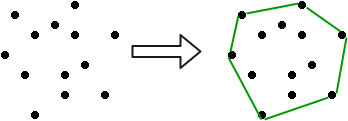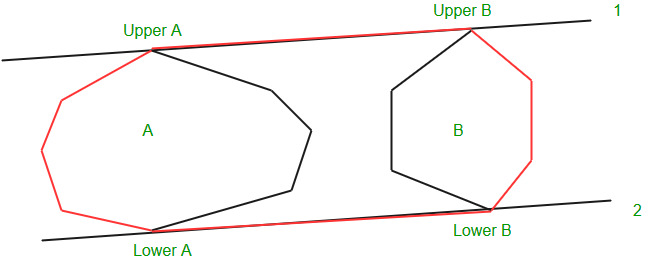凸包是包含所有给定点的最小凸多边形。

输入是由点的x和y坐标指定的点的数组。输出是这组点的凸包。
例子:
Input : points[] = {(0, 0), (0, 4), (-4, 0), (5, 0),
(0, -6), (1, 0)};
Output : (-4, 0), (5, 0), (0, -6), (0, 4)
前提条件:
两个凸多边形之间的切线
算法:
给定点集,我们必须为其找到凸包。假设我们知道左半点和右半点的凸包,那么现在的问题是合并这两个凸包,并确定整个集合的凸包。
这可以通过找到左右凸包的上切线和下切线来完成。这在此处说明了两个凸多边形之间的切线
令左凸包为a,右凸包为b。然后,将下切线和上切线分别命名为1和2,如图所示。
然后红色轮廓线显示了最终的凸包。 
现在问题仍然存在,如何找到左半边和右半边的凸包。现在,递归出现了,我们将点集除以集合中的点数非常少(例如5),然后可以通过brute算法找到这些点的凸包。这些一半的合并将导致凸包的完整点集。
笔记:
我们使用了蛮力算法来找到少量点的凸包,其时间复杂度为![]() 。但是有人建议如下,凸包的3点或更少点是完整的点集。这是正确的,但问题是当我们尝试合并2点的左凸包和3点的右凸包时,在某些特殊情况下,程序陷入了无限循环。因此,为了解决这个问题,我直接找到了凸壳的5个或更少的点
。但是有人建议如下,凸包的3点或更少点是完整的点集。这是正确的,但问题是当我们尝试合并2点的左凸包和3点的右凸包时,在某些特殊情况下,程序陷入了无限循环。因此,为了解决这个问题,我直接找到了凸壳的5个或更少的点![]() 最大的算法,但不影响算法的整体复杂性。
最大的算法,但不影响算法的整体复杂性。
// A divide and conquer program to find convex
// hull of a given set of points.
#include
using namespace std;
// stores the centre of polygon (It is made
// global because it is used in compare function)
pair mid;
// determines the quadrant of a point
// (used in compare())
int quad(pair p)
{
if (p.first >= 0 && p.second >= 0)
return 1;
if (p.first <= 0 && p.second >= 0)
return 2;
if (p.first <= 0 && p.second <= 0)
return 3;
return 4;
}
// Checks whether the line is crossing the polygon
int orientation(pair a, pair b,
pair c)
{
int res = (b.second-a.second)*(c.first-b.first) -
(c.second-b.second)*(b.first-a.first);
if (res == 0)
return 0;
if (res > 0)
return 1;
return -1;
}
// compare function for sorting
bool compare(pair p1, pair q1)
{
pair p = make_pair(p1.first - mid.first,
p1.second - mid.second);
pair q = make_pair(q1.first - mid.first,
q1.second - mid.second);
int one = quad(p);
int two = quad(q);
if (one != two)
return (one < two);
return (p.second*q.first < q.second*p.first);
}
// Finds upper tangent of two polygons 'a' and 'b'
// represented as two vectors.
vector> merger(vector > a,
vector > b)
{
// n1 -> number of points in polygon a
// n2 -> number of points in polygon b
int n1 = a.size(), n2 = b.size();
int ia = 0, ib = 0;
for (int i=1; i a[ia].first)
ia = i;
// ib -> leftmost point of b
for (int i=1; i=0)
inda = (inda + 1) % n1;
while (orientation(a[inda], b[indb], b[(n2+indb-1)%n2]) <=0)
{
indb = (n2+indb-1)%n2;
done = 0;
}
}
int uppera = inda, upperb = indb;
inda = ia, indb=ib;
done = 0;
int g = 0;
while (!done)//finding the lower tangent
{
done = 1;
while (orientation(a[inda], b[indb], b[(indb+1)%n2])>=0)
indb=(indb+1)%n2;
while (orientation(b[indb], a[inda], a[(n1+inda-1)%n1])<=0)
{
inda=(n1+inda-1)%n1;
done=0;
}
}
int lowera = inda, lowerb = indb;
vector> ret;
//ret contains the convex hull after merging the two convex hulls
//with the points sorted in anti-clockwise order
int ind = uppera;
ret.push_back(a[uppera]);
while (ind != lowera)
{
ind = (ind+1)%n1;
ret.push_back(a[ind]);
}
ind = lowerb;
ret.push_back(b[lowerb]);
while (ind != upperb)
{
ind = (ind+1)%n2;
ret.push_back(b[ind]);
}
return ret;
}
// Brute force algorithm to find convex hull for a set
// of less than 6 points
vector> bruteHull(vector> a)
{
// Take any pair of points from the set and check
// whether it is the edge of the convex hull or not.
// if all the remaining points are on the same side
// of the line then the line is the edge of convex
// hull otherwise not
set >s;
for (int i=0; i= 0)
pos++;
}
if (pos == a.size() || neg == a.size())
{
s.insert(a[i]);
s.insert(a[j]);
}
}
}
vector>ret;
for (auto e:s)
ret.push_back(e);
// Sorting the points in the anti-clockwise order
mid = {0, 0};
int n = ret.size();
for (int i=0; i> divide(vector> a)
{
// If the number of points is less than 6 then the
// function uses the brute algorithm to find the
// convex hull
if (a.size() <= 5)
return bruteHull(a);
// left contains the left half points
// right contains the right half points
vector>left, right;
for (int i=0; i>left_hull = divide(left);
vector>right_hull = divide(right);
// merging the convex hulls
return merger(left_hull, right_hull);
}
// Driver code
int main()
{
vector > a;
a.push_back(make_pair(0, 0));
a.push_back(make_pair(1, -4));
a.push_back(make_pair(-1, -5));
a.push_back(make_pair(-5, -3));
a.push_back(make_pair(-3, -1));
a.push_back(make_pair(-1, -3));
a.push_back(make_pair(-2, -2));
a.push_back(make_pair(-1, -1));
a.push_back(make_pair(-2, -1));
a.push_back(make_pair(-1, 1));
int n = a.size();
// sorting the set of points according
// to the x-coordinate
sort(a.begin(), a.end());
vector >ans = divide(a);
cout << "convex hull:\n";
for (auto e:ans)
cout << e.first << " "
<< e.second << endl;
return 0;
}
输出:
Convex Hull:
-5 -3
-1 -5
1 -4
0 0
-1 1
时间复杂度:左,右凸包的合并花费O(n)时间,并且在将点分成两个相等的部分时,因此上述算法的时间复杂度为O(n * log n)。
相关文章 :
- 凸包|设置1(贾维斯算法或包装)
- 凸包|套装2(Graham Scan)
- 凸包的Quickhull算法